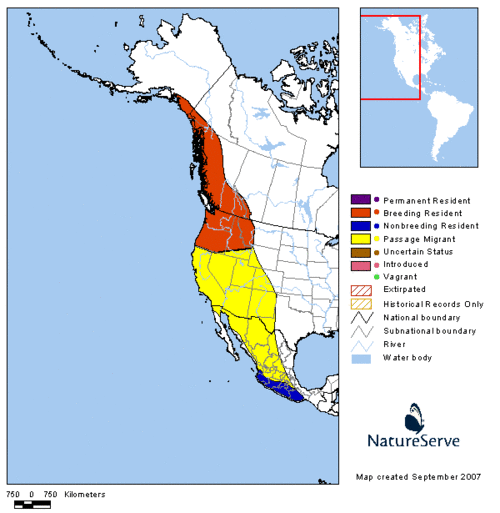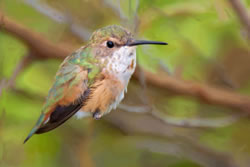Rufous hummingbird (Agriculture)
Contents
Rufous hummingbird
In strong sunlight, male Rufous hummingbirds put on quite a show with throat feathers flashing, a reddish orange iridescence brighter than a neon sign.
The Rufous Hummingbird:
Small but Feisty Long-Distance Migrant
 Distribution of the rufous hummingbird. Courtesy NatureServe. Many western and southwestern gardeners know the Rufous hummingbird (Selasphorus rufus) as a delightful often-unexpected visitor to colorful garden wildflowers or hummingbird feeders. These amazing small but feisty birds (only 3 inches or 8cm long) weigh merely three or four grams; for comparison, a United States penny weighs slightly about 2.5 grams). These birds are amazing aerialists, darting in and out, and can be relentless attackers of other birds and insects at feeders and flowers. They have long slender nearly straight bills. Their wings are relatively short and do not reach the end of the tail when the birds are perched on a feeder or nearby branches. They are also one of the few North American hummingbirds to migrate long distances. Rufous hummingbirds are a western species, rarely straying into the eastern United States.
Distribution of the rufous hummingbird. Courtesy NatureServe. Many western and southwestern gardeners know the Rufous hummingbird (Selasphorus rufus) as a delightful often-unexpected visitor to colorful garden wildflowers or hummingbird feeders. These amazing small but feisty birds (only 3 inches or 8cm long) weigh merely three or four grams; for comparison, a United States penny weighs slightly about 2.5 grams). These birds are amazing aerialists, darting in and out, and can be relentless attackers of other birds and insects at feeders and flowers. They have long slender nearly straight bills. Their wings are relatively short and do not reach the end of the tail when the birds are perched on a feeder or nearby branches. They are also one of the few North American hummingbirds to migrate long distances. Rufous hummingbirds are a western species, rarely straying into the eastern United States.
In strong sunlight, male Rufous put on quite a show with throat feathers flashing, a reddish orange iridescence brighter than a neon sign. Adult Rufous hummingbirds are often be confused with Allen’s hummingbirds (Selasphorus sasin). Allen’s hummingbirds have elongated scarlet gorget (throat) feathers. The tops of their heads and backs are a bronze or bronze-green in metallic shades. The sides of the face and flanks are often a rufous or cinnamon color, their chest is white, and there is a small white spot behind their black eye. Sometimes the feathers on the back of Allen’s males have a greenish color. However, if you notice any completely rufous (or rusty) feathers on their backs, you are looking at a Rufous hummingbird. Males of both species are more easily identified, but juvenile and female Rufous and Allen’s hummingbirds are virtually indistinguishable on the wing, especially during their migratory periods when their ranges overlap.
 Female rufous hummingbird. Although not the largest hummingbirds, Rufous are feisty, especially the males who chase and drive other hummers and large insects from their feeding territories. Rufous are pugnacious little birds. Feeding does not only include sucrose-rich floral nectars, Rufous have a high protein diet that comes from small insects. Various flies, wasps, bees and other small insects are consumed during high-speed encounters where birds splaying their bills open gulp down a meal as revealed in high-speed cinematography of captive individuals. Rufous, along with other hummingbirds, also practice a bit of larceny by stealing insects already caught in spider webs.
Female rufous hummingbird. Although not the largest hummingbirds, Rufous are feisty, especially the males who chase and drive other hummers and large insects from their feeding territories. Rufous are pugnacious little birds. Feeding does not only include sucrose-rich floral nectars, Rufous have a high protein diet that comes from small insects. Various flies, wasps, bees and other small insects are consumed during high-speed encounters where birds splaying their bills open gulp down a meal as revealed in high-speed cinematography of captive individuals. Rufous, along with other hummingbirds, also practice a bit of larceny by stealing insects already caught in spider webs.
Rufous hummingbirds exhibit amazing flight endurance on long-distance north and south migrations from southern Alaska to southernmost Mexico. These birds spend a large proportion of their time on the move following the bloom of their favorite plants. As champion migrants, they spend their summer breeding period, to the north in Washington, Oregon and westernmost Canada. Like some warmth-loving human tourists they spend their winter non-breeding months in southern Mexico especially in wooded areas in the state of Guerrero. Rufous make an annual circuit of the western states. Just passing through, they move into portions of California, Nevada, Utah, Colorado, Arizona, and New Mexico. Some Rufous individuals have been banded and are known to fly 2,000 miles during their migratory transits, and to live to an average ripe old age of eight years old. At 3,600 wing beats per minute, that is a huge amount of effort and energy expended for these sugar-loving animals. They routinely fly at 25 miles per hour but some species reach 50 mph in courtship displays.
In the southwestern deserts of the USA and Mexico, Rufous hummingbirds can be found feeding and defending their favorite blossoms. Some of these include: tree morning glories (Ipomoea arborescens), ocotillo (Foquieria splendens and F. macdougalii), various red mint flowers (Salvia elegans and Stachys coccinea), along with “shrimp plant” (Justicia californica and J. candicans).
For Additional Information
Become a citizen scientist and learn other fascinating information about Rufous hummingbirds on these websites. Your observations are important data for monitoring programs including Project FeederWatch (Cornell), NestWatch, or the Hummingbird Monitoring Network.
- Cornell Laboratory of Ornithology, and its Project FeederWatch.
- Journey North, sponsored by the Annenberg Foundation, for information on hummingbirds, monarch butterflies and other migratory animals.
- Arizona-Sonora Desert Museum, Center for Sonoran Desert Studies, Migratory Pollinators Program, Rufous hummingbirds.
- The Hummingbird Monitoring Network, a non-profit conservation organization that supports projects to improve hummingbird’s ability to survive and reproduce.
Editor's Note
- This article was written by Stephen Buchmann of the Pollinator Partnership

